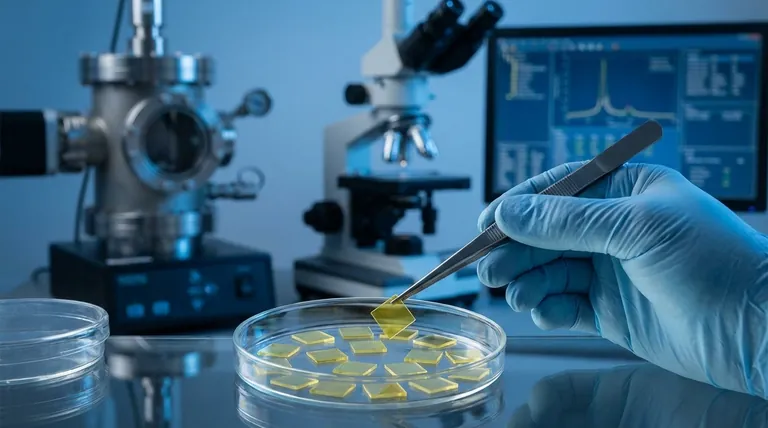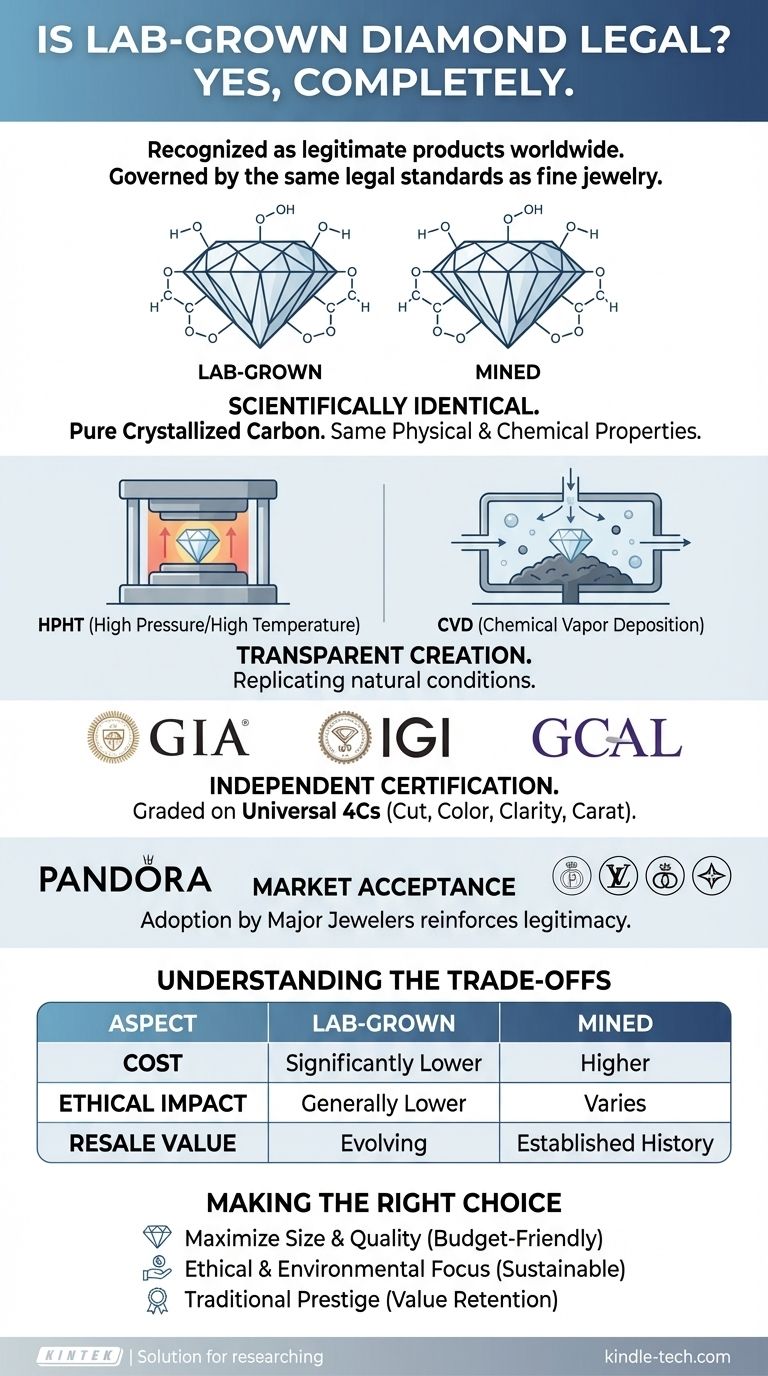Yes, lab-grown diamonds are completely legal. They are recognized and sold as legitimate products worldwide, with their trade governed by the same legal standards as any other piece of fine jewelry. Major industry bodies and government agencies consider them to be real diamonds, distinguished from natural diamonds only by their origin.
The question of legality is really a question of legitimacy. Lab-grown diamonds are not only legal but are scientifically identical to mined diamonds. Their growing acceptance by the world’s largest jewelers confirms their established place in the market.

What Defines a "Real" Diamond?
To understand the legal and commercial status of lab-grown diamonds, you first have to understand what they are: they are structurally and chemically identical to their mined counterparts.
Identical Chemical and Physical Structure
A diamond is defined by its composition and structure—it is crystallized carbon. Lab-grown diamonds are created using advanced technological processes that replicate the natural conditions of extreme heat and pressure that form diamonds in the Earth's mantle.
The result is a stone with the exact same physical, chemical, and optical properties as a mined diamond. They are indistinguishable without specialized gemological equipment.
The Misleading Nature of "Synthetic"
The term "synthetic" is sometimes used, but it can be misleading. In a scientific context, "synthetic" simply means it was synthesized by humans rather than by a natural process.
It does not mean "fake" or "simulated." A lab-grown diamond is a real diamond; a cubic zirconia or moissanite is a diamond simulant, which is a different and less valuable material.
How Lab-Grown Diamonds Are Made and Regulated
The legitimacy of lab-grown diamonds is reinforced by a transparent creation process and a robust system of third-party certification.
The Two Primary Creation Methods
There are two main processes for creating diamonds in a lab:
- HPHT (High Pressure/High Temperature): This method mimics the natural geologic process. A small diamond "seed" is placed in carbon and exposed to immense pressure and heat, causing the carbon to crystallize around the seed.
- CVD (Chemical Vapor Deposition): This method involves placing a diamond seed in a sealed chamber filled with carbon-rich gas. The gases are heated, causing carbon atoms to break apart and deposit onto the seed, growing a diamond layer by layer.
The Role of Independent Certification
Like mined diamonds, lab-grown diamonds are graded and certified by independent gemological laboratories. Reputable organizations like the Gemological Institute of America (GIA), the International Gemological Institute (IGI), and the Gem Certification & Assurance Lab (GCAL) issue reports for them.
These certificates verify the diamond's authenticity and grade its quality based on the universal "4Cs"—cut, color, clarity, and carat weight.
Market Acceptance by Major Jewelers
The most powerful proof of legitimacy is market adoption. Pandora, the world's largest jeweler by volume, has completely shifted from selling mined diamonds to only selling lab-grown diamonds, citing environmental and ethical reasons.
Other luxury brands are also incorporating lab-grown diamonds into their collections, signaling a definitive industry-wide acceptance.
Understanding the Trade-offs: Value and Perception
While scientifically identical, the market treats lab-grown and mined diamonds differently, which creates important trade-offs for a buyer to consider.
The Certification Nuance
While GIA does certify lab-grown diamonds, their certification process for them can be more expensive. Because a primary advantage of lab-grown diamonds is their affordability, most are certified by IGI, which provides highly respected and detailed reports at a lower cost.
This is not a reflection of lower quality but a practical market dynamic. An IGI-certified lab-grown diamond is a fully vetted and legitimate stone.
Cost vs. Long-Term Value
Lab-grown diamonds typically cost significantly less than mined diamonds of comparable size and quality. This makes larger or higher-quality stones more accessible.
However, the traditional market for mined diamonds has a long history of value retention and appreciation. The long-term resale value of lab-grown diamonds is still evolving as the market matures. The lower initial cost is the trade-off for a less established secondary market.
Making the Right Choice for Your Goal
Ultimately, the legality and legitimacy of lab-grown diamonds are well-established. The decision to buy one comes down to your personal priorities.
- If your primary focus is maximizing size and quality for your budget: Lab-grown diamonds offer significantly more value for your money.
- If your primary focus is ethical sourcing and environmental impact: Lab-grown diamonds bypass the concerns associated with traditional diamond mining.
- If your primary focus is traditional prestige and potential resale value: The mined diamond market has a longer and more established history of value retention.
Choosing a diamond is about selecting the stone that best reflects your values, budget, and aesthetic goals.
Summary Table:
| Aspect | Lab-Grown Diamonds | Mined Diamonds |
|---|---|---|
| Chemical Composition | Pure Crystallized Carbon | Pure Crystallized Carbon |
| Physical Properties | Identical to Mined | Identical to Lab-Grown |
| Primary Certification | IGI, GIA | GIA, IGI |
| Typical Cost | Significantly Lower | Higher |
| Ethical & Environmental | Generally Lower Impact | Varies by Mine Source |
Ready to explore high-quality, certified lab-grown diamonds for your research or collection? At KINTEK, we specialize in providing premium lab equipment and materials, including the technology behind these advanced gems. Whether you're a researcher, jeweler, or laboratory professional, we can help you source the right materials for your needs. Contact our experts today to discuss how we can support your projects with reliable, high-performance solutions.
Visual Guide

Related Products
- CVD Diamond for Thermal Management Applications
- Customer Made Versatile CVD Tube Furnace Chemical Vapor Deposition Chamber System Equipment
- Cylindrical Resonator MPCVD Machine System Reactor for Microwave Plasma Chemical Vapor Deposition and Lab Diamond Growth
- Chemical Vapor Deposition CVD Equipment System Chamber Slide PECVD Tube Furnace with Liquid Gasifier PECVD Machine
- 915MHz MPCVD Diamond Machine Microwave Plasma Chemical Vapor Deposition System Reactor
People Also Ask
- What is the use of CVD diamond? Unlock Superior Performance in Extreme Applications
- What are the disadvantages of CVD diamonds? Understanding the trade-offs for your purchase.
- Are lab-grown diamonds comparable to natural diamonds? Discover the Science Behind the Sparkle
- What is the difference between CVD and original diamond? Choose the Right Diamond for Your Needs
- What is the future of CVD diamond? Unlocking Next-Gen Electronics & Thermal Management



















